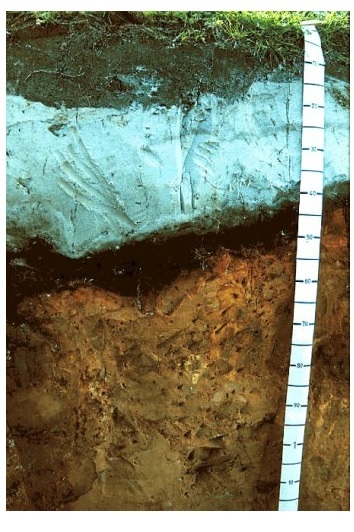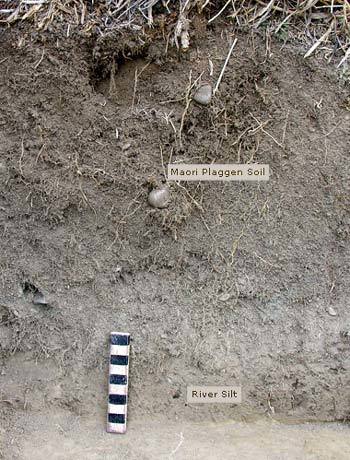A day’s sightseeing journey might include volcanic plateaus, rolling hills, river basins and coastal lands. It is easy to notice how the scenery changes from one place to the next, but the differences underground are not so obvious. As the landscapes change, so do the types of soils underlying them. These changes in soils are a result of how they were formed. The five factors that influence soil formation are parent material, climate, living organisms, topography and time.
Parent material
The rock from which soil is formed is called parent material. This can come fromweathered rock, volcanic ash or sediments moved and deposited by water, wind or glaciers. For example, the central North Island has soils that began as pumice from volcanic eruptions. The Waikato basin is an old flood plain of water-deposited volcanic debris. Soils in the Canterbury Plains have their origins in residuedeposited by glaciers – the residue washed out into river systems and was deposited in the low, relatively flat landscape.
Climate
Climate (temperature and rainfall) plays a large part in the weathering (breaking down) of parent materials.
Temperature effects:
- Rocks expand and contract as they heat up or cool, breaking them apart.
- Temperature controls the rates of chemical weathering (when water interacts with minerals in the rocks to create chemical reactions). Chemical weathering happens much faster in warm places like Northland than it does further south.
- Warmer temperatures may also mean more plant growth, soil organisms and litter decomposition.
Rain effects:
- Increased moisture means more plant growth.
- Rainwater washes materials off slopes.
- Rain dissolves minerals and leaches them deeper into the soil.
Living organisms
Living things influence soil formation in many ways. Plants, microorganisms, animals and even humans can make a difference. Once a plant community becomes established, it has a big effect on soil development. Tree roots penetrate deeply into soils, bringing up minerals and incorporating them into organic matter. Grasses penetrate less deeply but have increased biological activity and more rapid nutrient cycling.
New Zealand’s kauri trees have had a unique impact on soil formation. Kauri are large, long-lived trees. Over hundreds of years, rain dissolves strong acids from kauri leaf litter and leaches it underground. The acids strip aluminium and ironfrom the upper part of the soil, leaving a distinct white layer. The aluminium, iron and organic matter create a ginger-brown layer below. These soils look amazing but have low fertility and are very acidic.
Earthworms and other animals tunnel through and mix the soil. They aerate the soil and allow water to penetrate more deeply. Humans also influence soil formation. For example, Māori modified the soil in their kūmara gardens by adding sand and gravel to improve the drainage.
Topography
Topography refers to the lay of the land – the elevation and steepness of hills. Steep slopes can be more easily eroded, and rainfall tends to run off rather than infiltrate the soil.
Topography also influences climate. The South Island has a wide variety of soils due to the influence of the Southern Alps. Soil formation and the vegetation the soils support differ greatly on the very wet western slopes through to the dry basins of Canterbury and Central Otago.
Time
It takes a long time for soil to develop. For example, once rock is exposed in a warm, humid climate, it may take a hundred years for mosses and lichens to take hold. They trap dust and organic matter and break down the rock. Within a few hundred years, grasses and shrubs become established. Roots begin to penetrate the rocks and accelerate physical and chemical weathering. Over thousands of years, climate, organisms and topography influence how parent materials are turned into soils.
Soil formation and land use
Soil formation plays a part in agricultural land use. Fertilisers may be needed to supplement pumice soils low in certain minerals – like cobalt, selenium and copper– to ensure animal health. Soils in the Pukekohe and Gisborne Plains are ideal for market gardening because of their fertility and structure but must be protected from erosion. Indeed, all soils should be looked after. They take a very long time to form and are the basis of much of the life on Earth.
Nature of science
When scientists develop explanations about the world, they share data, information and explanations about phenomena they are trying to explain. Because scientists are communicating with other scientists, they need a common vocabulary. Soil scientists have developed a universal soilclassification system, one outcome of which is the construction of soil maps used to aid with land use, planning and environmental protection.


No comments:
Post a Comment